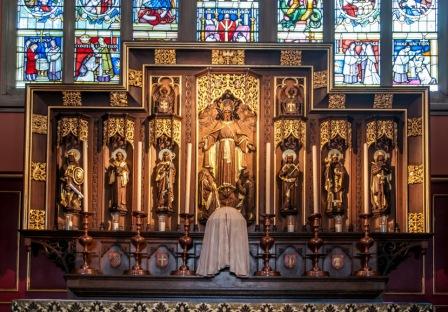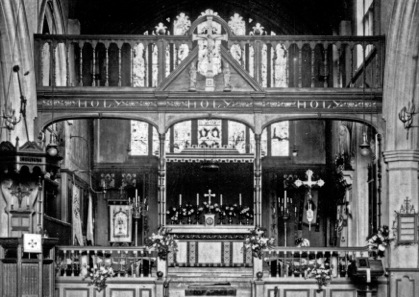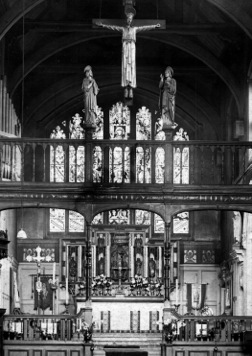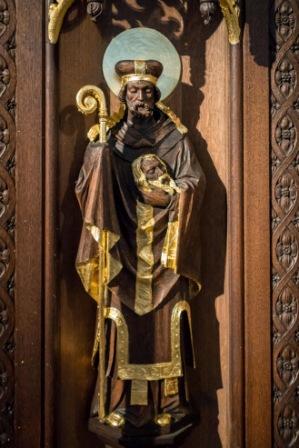
History of St Michael & All Angels
The refurbished Reredos (Altarpiece)
See also: The new Organ at St Michael & All Angels
 When admiring our magnificent new pipe organ, visitors cannot but also notice the newly gilded Reredos or Altarpiece at the High Altar (right). One consequence of the organ's completion was a realisation that the Altar and Tabernacle, surely the focus of all our worship, could not possibly yield pride of place in the Sanctuary to the organ. Hence the new gilding.
When admiring our magnificent new pipe organ, visitors cannot but also notice the newly gilded Reredos or Altarpiece at the High Altar (right). One consequence of the organ's completion was a realisation that the Altar and Tabernacle, surely the focus of all our worship, could not possibly yield pride of place in the Sanctuary to the organ. Hence the new gilding.
 Up till the early 1920s, the decoration behind the high altar was a plain fabric dossal hung from a rail, surmounted by a framed canopy (see picture, right)
Up till the early 1920s, the decoration behind the high altar was a plain fabric dossal hung from a rail, surmounted by a framed canopy (see picture, right)
Our altarpiece dates from 1923. The Reredos (picture, below right) was donated by the wife and daughters in memory of a long-serving Churchwarden, Matthew Pattison, who died in 1922 at the age of 55.
He had served as Churchwarden between 1904 until his death. He was a well-established Surveyor and Estate Agent, resident in Bedford Park for at least 20 years,  latterly at 50 Esmond Road. His wife, Ida Caroline, who lived on until 1930, is commemorated in a second plaque.
latterly at 50 Esmond Road. His wife, Ida Caroline, who lived on until 1930, is commemorated in a second plaque.
The Altarpiece originally bore gilding, though apparently applied with a different and perhaps heavier emphasis than the recent renovation. It is unclear when the original gilding was removed, though it is likely to have occurred in the austere period just after the war during repairs after a V-bomb raid had destroyed the original East Window and seriously damaged the Chancel in 1944.
The intricate carving deserves a close look. The central panel shows Christ, ascending in Glory and the figures of Our Lady and St. John kneeling in adoration. The surrounding six canopied niches contain carved figures. They are Saints and Kings considered influential in the development of the pre-Norman English church. Quite why this theme for the figures was chosen is quite obscure.
The Vicar of the time, Revd. Jacob Cartmel-Robinson, was definitely a staunch high churchman and it might have thought that any altar figures would have had an Anglo-Catholic or even "Roman" emphasis. Perhaps they were chosen as a particular wish of the donor, or the deceased, or it may have been the wish of influential members of the Parochial Council of the time - much as was the introduction of the statue of St Joan at the West of the church during the same decade.
At the far right is King Alfred. His reign saw the first fragments of the bible translated from the Latin into the Anglo-Saxon vernacular, increasing learning, re- established religious institutions and legal reform. He is seen with a sheathed sword, symbolic of his peace-seeking rule, and carrying the Book.
The left-hand King is evidently a Viking warrior, his sword drawn ready for battle. For many years he was thought to represent Magnus the Martyr, an early king of Orkney. A modern view, however, would favour King Knut (Canute), the first King of an unified England as a better candidate. He is well known to have been almost ostentatiously pious - some say his piety was largely a political necessity to gain control of the powerful church hierarchy, but nevertheless he was enormously supportive of English Christianity, both by his many endowments and by his personal example. The incident with the waves was his demonstration of how temporal power was as nothing compared with the power of God.
The female figures represent St Helena (right) and St Milburga or Ermingilda (left). Helena was the Roman Emperor Constantine's mother, who gave birth to him when in York with her husband Constantinus who governed the Northern province before himself being acclaimed Roman Emperor. After conversion, She was a very devoted pilgrim, noted for her establishment of churches in Jerusalem, and her discovery of the Holy Cross there. Hence she is always represented carrying a cross. Milburga is, by contrast, a fairly obscure saint. A daughter of King Merewald, and sister of St Mildred, she was the founding Abbess of Wenlock Priory in Shropshire, probably endowed by her father. Her mother had been Abbess of Thanet, so sanctity rather ran in the family. Milburga is said to have powers over birds, and is usually represented with a goose. She also apparently had the power of levitation, able to float on a sunbeam, or in some versions, a tongue of fire. She is credited thereby to have restored a young son of a supplicant from the dead.
 The other male figures are SS Cuthbert (picture right), and Bede. Cuthbert, originally a Northumbrian shepherd boy, eventually became Abbot of the Holy Island of Lindisfarne succeeding St Aidan, the founder. The land for the monastery had been given by the King of Northumbria, Oswald, whose sainthood arose from his death in the Christian cause in battle against the pagan Penda of Mercia at Maserfeld in 642. The head of Oswald was brought to Lindisfarne. Although Cuthbert was not contemporary with Oswald and never met him, Oswald's relic was hidden in his tomb when Lindifarne was threatened by the Vikings in 875. Cuthbert's tomb was eventually translated to Durham, together with Oswald's relic in 998. This is why Cuthbert is often depicted holding the severed head of Oswald. A less likely alternative candidate for our statue could have been St Alban, the first English martyr, from the third century, who is sometimes depicted bearing his own head. Our statue shows that Cuthbert is holding a different person's head, certainly bare of an Abbot's mitre, so he seems not to be a true "cephalophore" like Alban, who in any case was never ordained, and therefore not entitled to wear a mitre.
The other male figures are SS Cuthbert (picture right), and Bede. Cuthbert, originally a Northumbrian shepherd boy, eventually became Abbot of the Holy Island of Lindisfarne succeeding St Aidan, the founder. The land for the monastery had been given by the King of Northumbria, Oswald, whose sainthood arose from his death in the Christian cause in battle against the pagan Penda of Mercia at Maserfeld in 642. The head of Oswald was brought to Lindisfarne. Although Cuthbert was not contemporary with Oswald and never met him, Oswald's relic was hidden in his tomb when Lindifarne was threatened by the Vikings in 875. Cuthbert's tomb was eventually translated to Durham, together with Oswald's relic in 998. This is why Cuthbert is often depicted holding the severed head of Oswald. A less likely alternative candidate for our statue could have been St Alban, the first English martyr, from the third century, who is sometimes depicted bearing his own head. Our statue shows that Cuthbert is holding a different person's head, certainly bare of an Abbot's mitre, so he seems not to be a true "cephalophore" like Alban, who in any case was never ordained, and therefore not entitled to wear a mitre.
Bede needs little introduction. A life-long monk at the monastery of St Paul at Jarrow, his writings, especially his "Ecclesiastical History of the English people" earned him the name "Father of English History". He is seen with book and pen, with other books at his feet. His work includes much biographical information about the saints and monarchs of the period represented in our Reredos.
At the foot of the Reredos can be seen red shields bearing the Instruments of the Crucifixion: a cross, hammer, nails, pliers, spear and sponge,whip and column, robe and crown of thorns. These reflect the designs in the mosaic pavement beneath the high altar dating from a much earlier period, the incumbency of the first vicar, Revd. Alfred Wilson, 1879 - 1904.
David Beresford